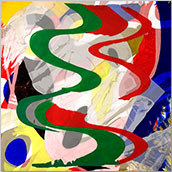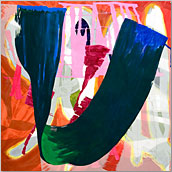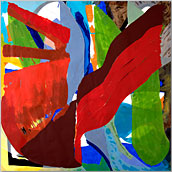ELLEN PRIEST
Ellen Priest
By Edward Higgins
Reprinted with permission from Primetime Art & Entertainment,March 2007.
The saturated colors of Ellen Priest’s collages and their untamed forms and shapes do nothing less than let the viewer see the music. In this case the music is Edward Simon’s Venezuelan Suite and the venue to hear and see the music is the Berman Museum of Art on the campus of Ursinus College through April 5. The show’s formal title is Ellen Priest – Jazz Paintings on Paper: Improvisations on the Venezuelan Suite and comprises some two dozen plus works most of which are drawn from Simon’s music.
Priest also is showing works inspired by Herbie Hancock and Chick Corea. She has also used the work of Miles Davis. According to the artist, "Since 1990 my abstract paintings have been based on jazz. I work in series, one jazz composition serving as the subject matter for eight to 20 paintings. My media are oil and flashe [an acrylic paint with saturated color] on layered paper, some translucent...one literally sees a painting through a painting. My paintings are as rhythmic, translucent and constantly moving as the jazz on which they are based."
"A jazz composition does for me exactly what a mountain panorama does for a landscape artist working outdoors," she says. Priest will return and return again to the same composition in music to make that music translate as best she can into colors. And these colors are not spare; her canvasses in this show are 42 inches by 42 inches.
Priest is not an overnight wonder. She has been pursuing her art for a number of years. She was graduated from Lawrence University with a BA and then took an interdisciplinary program at Yale, which awarded her a master’s of divinity and fine art. Her work has also earned a number of prestigious awards including the Pollock-Krasner grant in 2001. Priest has taught drawing and painting at Choate-Rosemary Hall, The Hammonassett School, the Concord Academy and the Ocean City Arts Center. Her work has been shown in numerous group and solo exhibitions and are held in a number of private collections.
At the Berman, the Simon jazz suite plays while one wanders the gallery. It is easy to fancy that some of the colors and forms represent notes, chords or instruments in a representational sense, but also in that sense of emotional drama we all carry with us.
The notion of color and music being related is not new. A sub-school of cubism was developed by two American artists studying in Paris in the decade after the turn of the century. Morgan Russell and Stanton Macdonald Wright were friends with and influenced by Picasso, Matisse, and Cezanne. They invented something they called "Synchronism" which sought to create emotion such as one experienced with music through the use of color. They talked about their art in terms of music and believed that color had an equivalent sound.
This is not to say that Priest is redoing an old theme. Her involvement with the music that inspires her and the number of images that inspiration generates signify that there is a close emotional connection, but not that each stroke in a particular work represents a particular chord or note in the jazz composition.
Other artists have had success with this concept, most particularly Piet Mondrian whose Broadway Boogie Woogie easily captures the sights, sounds and energy of the New York subway system. In fact it was so perfectly matched that the subway system made new maps of the underground that were highly derivative of the Mondrian.
Priest’s images have a distinctive modern contemporary feel to them that is perfectly in sync with the music she is translating. The colors are typically applied to sheets of paper and then cut out into the desired forms. Priest then gets down to the construction of the piece as she layers the papers in such a way as to create sculptural effects and to increase the feeling of depth. All of the work is noted as to the music that inspired it and then a simple consecutive number.
The art also works exceptionally well in the light, airy Berman, surrounded by basic earth colors that heighten the effects of Priest’s music paintings.
Edward Higgins is a member of The Association Internationale Des Critiques d’Art.
By Edward Higgins
Reprinted with permission from Primetime Art & Entertainment,March 2007.
The saturated colors of Ellen Priest’s collages and their untamed forms and shapes do nothing less than let the viewer see the music. In this case the music is Edward Simon’s Venezuelan Suite and the venue to hear and see the music is the Berman Museum of Art on the campus of Ursinus College through April 5. The show’s formal title is Ellen Priest – Jazz Paintings on Paper: Improvisations on the Venezuelan Suite and comprises some two dozen plus works most of which are drawn from Simon’s music.
Priest also is showing works inspired by Herbie Hancock and Chick Corea. She has also used the work of Miles Davis. According to the artist, "Since 1990 my abstract paintings have been based on jazz. I work in series, one jazz composition serving as the subject matter for eight to 20 paintings. My media are oil and flashe [an acrylic paint with saturated color] on layered paper, some translucent...one literally sees a painting through a painting. My paintings are as rhythmic, translucent and constantly moving as the jazz on which they are based."
"A jazz composition does for me exactly what a mountain panorama does for a landscape artist working outdoors," she says. Priest will return and return again to the same composition in music to make that music translate as best she can into colors. And these colors are not spare; her canvasses in this show are 42 inches by 42 inches.
Priest is not an overnight wonder. She has been pursuing her art for a number of years. She was graduated from Lawrence University with a BA and then took an interdisciplinary program at Yale, which awarded her a master’s of divinity and fine art. Her work has also earned a number of prestigious awards including the Pollock-Krasner grant in 2001. Priest has taught drawing and painting at Choate-Rosemary Hall, The Hammonassett School, the Concord Academy and the Ocean City Arts Center. Her work has been shown in numerous group and solo exhibitions and are held in a number of private collections.
At the Berman, the Simon jazz suite plays while one wanders the gallery. It is easy to fancy that some of the colors and forms represent notes, chords or instruments in a representational sense, but also in that sense of emotional drama we all carry with us.
The notion of color and music being related is not new. A sub-school of cubism was developed by two American artists studying in Paris in the decade after the turn of the century. Morgan Russell and Stanton Macdonald Wright were friends with and influenced by Picasso, Matisse, and Cezanne. They invented something they called "Synchronism" which sought to create emotion such as one experienced with music through the use of color. They talked about their art in terms of music and believed that color had an equivalent sound.
This is not to say that Priest is redoing an old theme. Her involvement with the music that inspires her and the number of images that inspiration generates signify that there is a close emotional connection, but not that each stroke in a particular work represents a particular chord or note in the jazz composition.
Other artists have had success with this concept, most particularly Piet Mondrian whose Broadway Boogie Woogie easily captures the sights, sounds and energy of the New York subway system. In fact it was so perfectly matched that the subway system made new maps of the underground that were highly derivative of the Mondrian.
Priest’s images have a distinctive modern contemporary feel to them that is perfectly in sync with the music she is translating. The colors are typically applied to sheets of paper and then cut out into the desired forms. Priest then gets down to the construction of the piece as she layers the papers in such a way as to create sculptural effects and to increase the feeling of depth. All of the work is noted as to the music that inspired it and then a simple consecutive number.
The art also works exceptionally well in the light, airy Berman, surrounded by basic earth colors that heighten the effects of Priest’s music paintings.
Edward Higgins is a member of The Association Internationale Des Critiques d’Art.


